Blood Typing Activity
The Patient
You are a lab tech in a hospital. A doctor has a patient who needs a blood transfusion. You have three potential donors. Determine the blood type of the patient and donors. Then, decide who would be an appropriate donor.
Kim is a 43 year old woman who has been in a car crash. She lost a lot of blood through an injury to her leg. Before you can give her a transfusion, you need to determine her blood type. Let’s go down to the lab to walk through the procedure.
In your lab, you have a blood sample and three reagents.
- a serum with synthetic antibody-A
- a serum with synthetic antibody-B
- a serum with synthetic antibody-Rh
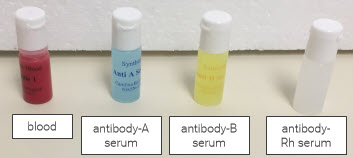
When the antibody serums are added to a blood sample with the given antigen, they agglutinate, or clump. We can use that knowledge to determine a blood type.

See the visible darker red spots and clear areas in the samples above? That’s agglutination.
Start the Test
Start by adding the blood sample to each of the three marked wells in the sample tray.
Open Add Patient Blood Sample in a new tab
Add the antibody-A serum the blood sample in the wells.
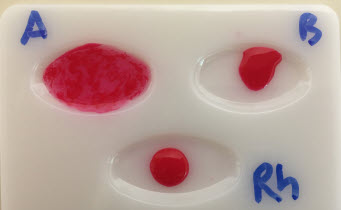
Do you see agglutination?
Answer: Yes. Since you see agglutination, you know that A antigens are present.
You know that A antigens are present. So, what blood types could our patient have?
Answer: Based on the presence of A antigens, the patient could have A+, A-, AB+, or AB-.
We can narrow the blood type down farther by testing for the B antigen. Add the antibody-B serum to the blood sample.
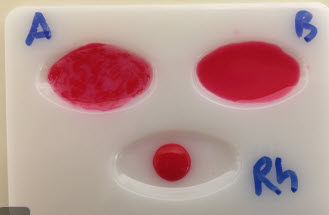
Do you see agglutination?
Answer: No. Since you do not see agglutination, you know that B antigens are not present.
You know that A antigens are present and B antigens are not present. With this new information, what blood types could our patient have?
Answer: Based on the presence of A antigens and absence of B antigens, we have narrowed the blood types to A+ or A-.
We make our final determination of blood type by testing for the Rh antigen. Add the antibody-Rh serum to the blood sample.
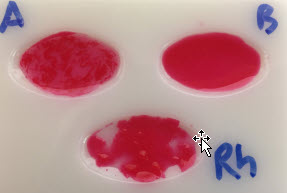
Do you see agglutination?
Answer: Yes. Since you see agglutination, you know that Rh antigens are present.
You know that A and Rh antigens are present and B antigens are not present. With this new information, what is our patient’s blood type?
Answer: Since the patient has A and Rh antigens, she has A+ blood. Remember that when you select an appropriate donor.
The Potential Donors
The doctor has three potential donors. Before she can decide on a donor, she needs to know their blood types.
Donor 1
Start by adding the blood sample to each of the three marked wells in the sample tray.
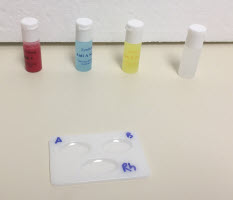
Add all three antibody serums to the tray. Look at the sample. Which antibodies show agglutination?

Answer: The antibody-B and antibody-Rh serum caused agglutination.
You know that B and Rh antigens are present. So, what blood type is our donor?
Answer: Since Donor 1 has B and Rh antibodies, his blood is B+.
Donor 2
Start by adding the blood sample to each of the three marked wells in the sample tray.

Add all three antibody serums to the tray. Look at the sample. Which antibodies show agglutination?

Answer: The antibody-A and antibody-B serum caused agglutination.
You know that A and B antigens are present. So, what blood type is our donor?
Answer: Since Donor 2 has A and B antibodies, her blood is AB-.
Donor 3
Start by adding the blood sample to each of the three marked wells in the sample tray.

Add all three antibody serums to the tray. Look at the sample. Which antibodies show agglutination?
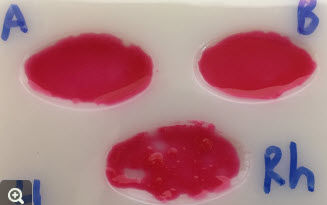
Answer: The antibody-Rh serum caused agglutination.
You know that Rh antigens are present. So, what blood type is our donor?
Answer: Since Donor 3 has Rh antibodies only, her blood is O+.
Now, we have the blood type for our accident victim (A+) and our three potential donors.
- Donor 1: B+
- Donor 2: AB -
- Donor 3: O+
Based on this information, who is a potential donor for our victim?
Answer: O+ blood is compatible since the patient does not produce any antibodies against this type.
You have successfully identified the blood types of the victim and donors. You have also identified a suitable donor for the victim. Congratulations on saving a life!